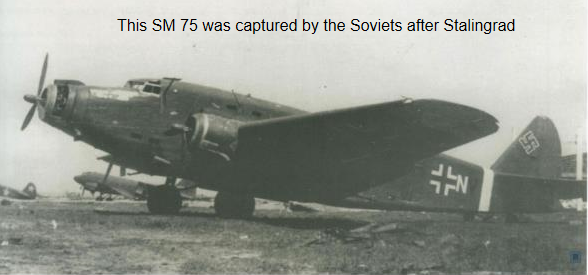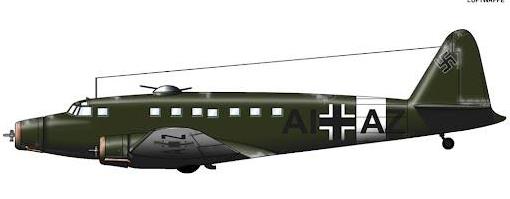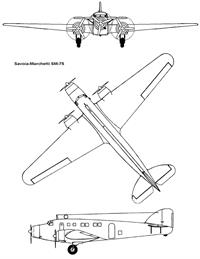

The Savoia-Marchetti SM.75 - a three-engined cantilever low-wing aircraft - took off for the first time on November 6, 1937. The plane accommodated 30 passengers. Five aircraft of the first batch were delivered to Ala Littoria, one aircraft to the Italian Ministry of Aviation together with the aircraft of the Italian Air Force (starting with registration number MM 384). The first experience with the SM.75 model has confirmed its capabilities and effectiveness. In the period from 1937 to 1943. a total of 90 aircraft were produced. The engines usually used were Alfa Romeo 126 RC.34 engines. 11 aircraft powered by Alfa Romeo 126 RC.18 radial engines were designated SM.75bis. Ala Littoria used a total of 38 machines.
In 1939, the newly formed Italian airline Linee Aeree Transcontinentali Italiane (LATI), formed to fly to Natal and Rio de Janeiro in Brazil, received its first SM.75 aircraft. At the end of 1940, this aircraft received a new designation. The SM76 after its fuselage was lengthened and widened, its wing redesigned, its fuel tanks increased, and Pratt & Whitney Twin Wasp radial engines installed. In 1939, several SM.75s were produced under license in Hungary. These aircraft were powered by Gnome-Rhone Mistral Major 14K engines (Hungarian version - Weiss Manfred WM K-14). In 1940, all SM.75s were taken over by the army and used by special transportation and communications services. All military aircraft were named "Marsupiale". During operation, most of the machines were upgraded - the engines were replaced with more powerful Piaggio P.XI RC.40.
In 1939, the SM.87Idro seaplane was built, which was a variant of the SM.75 mounted on floats. Three Fiat A.80 radial engines with a capacity of 1000 hp were installed as a power plant. The SM.87 was tested by pilot Alesandro Passalevo. As expected, the characteristics of the float aircraft slightly decreased, but in terms of basic parameters, the SM.87 was practically not inferior to ground-based aircraft. In 1939-1940. built 4 such aircraft, first assigning them civil registration codes (I-GOR, I-INNO, I-ILLA, I-IGEA), and after entering the war, replacing them with military MM.447 - MM.450.
All aircraft survived the 1940-1943 Allied campaign. and after the division of Italy became part of the RSI aviation. Since Mussolini's troops were actually subordinate to Germany, the planes were assigned German registration codes. The SM.87 Idro was operated on the internal lines of the Third Reich, being involved in various transport services. The traces of the last planes are lost in the fall of 1944.
The only one left was a sample of the SM.90 aircraft. By lengthening the fuselage to 23.9 m and installing more powerful Alfa Romeo 135 engines (1400 hp), it was planned to increase the commercial data of the transport aircraft, but later it was decided to abandon this option in favor of newer developments. In addition, after the war, there were a sufficient number of American military aircraft built on the basis of the DC-3 and doing an excellent job of their tasks.
The SM.75 first came to the front in August 1940, when one of these machines was sent to Corpo Aereo Italino, who arrived in Belgium to participate in raids against the British. The SM.75 served as General Corso-Fuge's personal aircraft. Then the transport workers were involved in supplying the Italian troops trying to break through the Greek defenses. One SM.75 served as the personal aircraft of General Di Scuadro Francesco Prikolo. On October 5, 1941, he flew to Kryvyi Rih, but when he was going back to Italy, it turned out that his plane could not take off due to technical problems, as a result of which the general was forced to use Ju.52/3m from "Ala Littoria" ... However, the real test fell to the lot of the planes "sent" to Africa.
It turned out to be a big mistake of the Italians to unleash a war against the British on the territory under their control. During the first two months of fighting, the situation on the African front changed so much that the Italian Expeditionary Force itself found itself in a defensive position. In such conditions, the question of supplying the retreating army was more acute than ever, and here the special aviation service (Servizi Aerei Speciali - SAS) created in June 1940 came in handy. It consisted of 31 SM.75 aircraft and four Ju.52 / 3m aircraft, distributed among seven air groups located at airfields in Italy, Albania and Libya. The connected SM.82s carried Fiat CR.42 fighters to Africa, while the SM.75 carried equipment. By June 1941, in Italian Somalia, there was only one airfield not captured by the British, available for transport aviation operations - Gondar. From there he made the last super-long flights SM.75 with the I-LUNO board code and the emblem of the Red Cross. The aircraft was piloted by Captain Max Peroli, who had previously distinguished himself by the heroic flight of three transport S.73s from the besieged Addis Ababa. The first such flight flew through French Somalia and Libya directly to Rome and had a length of about 12,000 km. Until September, Peroli made four more flights to Gondar, until his equally heroic SM.75 burned down during a raid of South African aircraft at the Djibouti airfield. 73 from besieged Addis Ababa. The first such flight flew through French Somalia and Libya directly to Rome and had a length of about 12,000 km. Until September, Peroli made four more flights to Gondar, until his equally heroic SM.75 burned down during a raid of South African aircraft at the Djibouti airfield. 73 from besieged Addis Ababa. The first such flight flew through French Somalia and Libya directly to Rome and had a length of about 12,000 km. Until September, Peroli made four more flights to Gondar, until his equally heroic SM.75 burned down during a raid of South African aircraft at the Djibouti airfield.
After the loss of East African possessions, Italian warplanes no longer appeared in this sector of Africa. The only exception was the SM.75. In March 1942, a single SM.75GA, flying over Egypt, Sudan and Ethiopia, dropped leaflets over the city of Asmara for the Italian population.
The restless captain Peroli did not leave Africa alone. On May 23, 1943, two SM.75GAs (MM60534 coded I-TAMO and MM60539 coded I-BUBA) took off from the Gaddur airfield on the island of Rhodes, piloted by Maggiore Giuilio Cesare Villa and Captain Peroli. The crews of the transport workers were given a completely uncharacteristic task of bombing the Gure airfield (Eritrea), where a large American air base was located. The flight distance was about 6,000 km, but on the way it turned out that the fuel was consumed too quickly on the MM60539 aircraft and only MM60534 went to Gure, and the first crew bombed Port Sudan. After completing the task, both aircraft returned to Rhodes, and after the bombing of the American base, a major fire broke out on it.
For the SM.75, the war in Africa ended in a tragic epic with the removal of the Italian expeditionary corps. As for other transport aircraft (the SM.82 and Fiat G.12 also participated in the evacuation), flights across the Mediterranean Sea and, in general, being at airfields within the reach of allied aviation became very dangerous. The SM.75 is, one might say, lucky in this regard. The losses of this type of aircraft were relatively small, while the Mediterranean became a real graveyard for the German Ju-52/ 3m and the huge Me.323.
In early September 1943, all SM.75s in German-controlled territory were captured and captured to Germany. Later, some of them were returned to the Air Force of the Socialist Republic of Italy, which continued to operate them until May 1945. It was on the SM.75GA that Mussolini could have been saved, but the rapidly changing situation in the country forced the Italian dictator to look for other ways to escape. When the war ended, the SM.75 became part of the new Italian Air Force and served until 1949.


| Type |
4 (+1 in military use) , 24 passengers |
| Engine |
3 Alfa-Romeo 126 R.C.34 or 3 Piaggio P.XI R.C.40 |
| Dimensions |
Length 21,60 m, height 5,10 m, span 29,69 m, wing area 118,55 m2 |
| Weights |
Empty 9480 kg, (with Piaggio engines 9780 kg), loaded 14470 kg (with Piaggio engines 14769 kg) |
| Performance |
Max. speed 369 km/h at 3069 m, on 2 engines 289,7 km/h, with Piaggio engines 245 km/h, cruising speed 325 km/h , with Piaggio engines 214 km/h, range 2279 km, with Piaggio engines 999 km, service ceiling 7000 m, on 2 engines 4400 m, with Piaggio engines 999 km, climb to 4000 m 17 min. 42 sec., with Piaggio engines to 4000 m 19 min. |
| Armament, military version |
|
| Type |
Werk.Nr |
Registration |
History |
|
32060 |
I-TAMO, MM.52596, D-APOC |
Ergänzungs-Transportgeschwader Luftflotte 14 Prag-Rosyn |
|
32026 |
I-LAOS, MM.46708, D-ARBO |
Ergänzungs-Transportgeschwader Luftflotte 6 Dresden-Klotsche |
|
32028 |
I-LINI, D-ASVD |
Ergänzungs-Transportgeschwader Luftflotte 6 Dresden-Klotsche |
|
32043 |
I-LAST, MM.46708, D-ATAD |
Ergänzungs-Transportgeschwader Luftflotte 14 Prag-Rosyn |
|
32061 |
I-MASO, D-ATVQ |
Fliegerkorps 14 Breslau-Gandau |
|
32042 |
I-LEGA, D-AUGU |
Transferred to Lufthansa, stripped for useful parts then scrapped |
|
32002 |
D-AVAB |
Transferred to Lufthansa but left at Milan |
|
60008 |
I-BUMA, MM.46708, D-AIAW |
Ergänzungs-Transportgeschwader Luftflotte 14 Breslau-Gandau |
|
32017 |
I-TUON, MM60539, D-AIAX |
Reichflotte Berlin, Tempelhof |
|
32056 |
I-BUBA, D-AIAZ |
OKL Versuchsabteilung 2, Fliegerkorps 14, Breslau-Gandau |
|
32021 |
I-TETI, MM60308, D-AOAR |
Reichflotte Berlin, Tempelhof |
|
32014 |
I-TEBI, MM.52596, , D-AOHC |
Ergänzungs-Transportgeschwader 4 |


